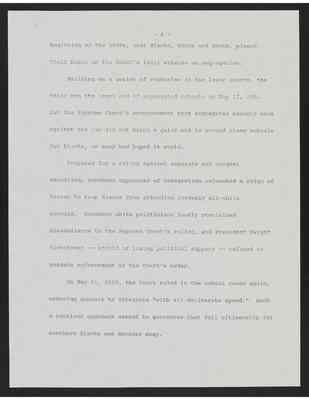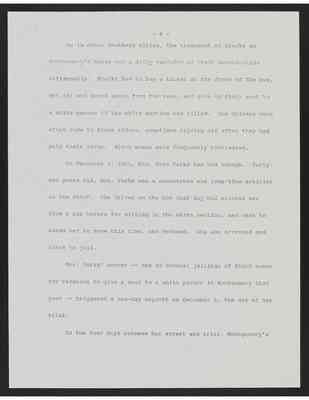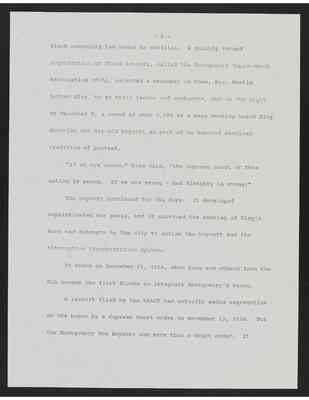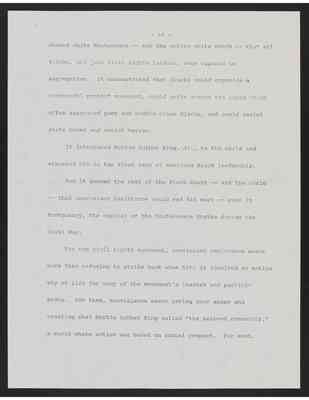Pages
6
-6-
beginning of the 1950s, most Blacks, North and South, placed their hopes on the NAACP's legal attacks on segregation.
Building on a series of victories in the lower courts, the NAACP won the legal end of segregated schools on May 17, 1954. But the Supreme Court's announcement that segregated schools were against the law did not bring a quick end to second class schools for blacks, as many had hoped it would.
Prepared for a ruling against separate and unequal education, southern opponents of integration unleashed a reign of terror to keep Blacks from attending formerly all-white schools. Southern white politicians loudly proclaimed disobedience to the Supreme Court's ruling, and President Dwight Eisenhower -- afraid of losing political support -- refused to mandate enforcement of the Court's order.
On May 31, 1955, the Court ruled in the school cases again, ordering schools to integrate "with all deliberate speed." Such a cautious approach seemed to guarantee that full citizenship for southern Blacks was decades away.
7
-7But the Black South was determined to push forward at its own speed.
In 1953, in Baton Rouge, Louisiana, Blacks staged a successful 10-day boycott of the city's buses aimed at ending the requirement that Blacks give up their seats to whites. The boycott ended when Baton Rouge agreed to a first-come, first-served system with Blacks seated from the rear and whites seated from the front.
The Baton Rouge boycott marked the beginning of a new kind of Black protest. It was a mass movement, based in Baton Rouge's Black churches. Directed by a coalition of civic and civil rights organizations, including the NAACP, it rejected the NAACP's legal approach as too expensive and too slow.
Two years after the Baton Rouge bus boycott, a similar protest began in Montgomery, Alabama, that would become world-famous and would introduce the world to a new Black leader named Martin Luther King, Jr.
8
-8As in other Southern cities, the treatment of Blacks on Montgomery's buses was a daily reminder of their second-class citizenship. Blacks had a buy a ticket at the front of the bus, get off and board again from the rear, and give up their seat to a white person if the white section was filled. Bus drivers were often rude to Black riders, sometimes driving off after they had paid their fares. Black women were frequently mistreated.
On December 1, 1955, Mrs. Rosa Parks had had enough. Forty-two years old, Mrs. Parks was a seamstress and long-time activist in the NAACP. The driver on the bus that day had evicted her from a bus before for sitting in the white section, and when he asked her to move this time, she refused. She was arrested and taken to jail.
Mrs. Parks' arrest -- one of several jailings of Black women for refusing to give a seat to a white person in Montgomery that year -- triggered a one-day boycott on December 5, the day of her trial.
In the four days between her arrest and trial, Montgomery's
9
-9Black community had begun to mobilize. A quickly formed organization of Black leaders, called the Montgomery Improvement Association (NTA), selected a newcomer in town, Rev. Martin Luther King, to be their leader and spokesman, and on the night of December 5, a crowd of over 5,000 at a mass meeting heard King describe the day-old boycott as part of an honored American tradition of protest.
"If we are wrong," King said, "the Supreme Court of this nation is wrong. If we are wrong - God Almighty is wrong!"
The boycott continued for 381 days. It developed sophisticated car pools, and it survived the bombing of King's home and attempts by the city to outlaw the boycott and its alternative transportation system.
It ended on December 21, 1956, when King and others from the MIA became the first Blacks to integrate Montgomery's buses.
A lawsuit filed by the NAACP had actually ended segregation on the buses by a Supreme Court order on November 13, 1956. But the Montgomery Bus Boycott won more than a court order. It
10
showed white Montgomery -- and the entire white South -- that all Blacks, not just civil rights leaders, were opposed to segregation. It demonstrated that Blacks could organize a successful protest movement, could unite across the lines which often separated poor and middle class Blacks, and could resist state power and racist terror.
It introduced Martin Luther King, Jr., to the world and elevated him to the front rank of American Black leadership.
And it showed the rest of the Black South -- and the world -- that nonviolent resistance could and did work -- even in Montgomery, the capital of the Confederate States during the Civil War.
For the civil rights movement, nonviolent resistance meant more than refusing to strike back when hit; it involved an entire way of life for many of the movement's leaders and participants. For them, nonviolence meant loving your enemy and creating what Martin Luther King called "the beloved community," a world where action was based on mutual respect. For most,




